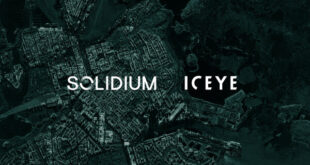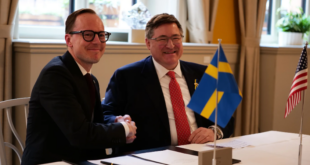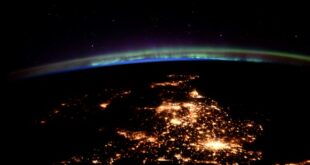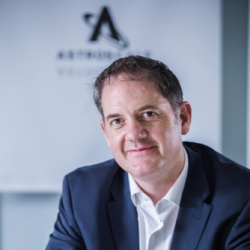 Millions of pieces of space debris can cause potential damage to many active satellites. Founded in 2013, Astroscale is focused on the development of new and innovative technologies necessary to remove space debris and ensure space sustainability. Maruska Strah of SpaceWatch.Global interviewed Mr. Chris Blackerby, Group COO and Director of Astroscale’s Japan Office and discussed the company’s missions for space debris removal and recognition as the Forbes Japan Start Up of the Year 2019 Award.
Millions of pieces of space debris can cause potential damage to many active satellites. Founded in 2013, Astroscale is focused on the development of new and innovative technologies necessary to remove space debris and ensure space sustainability. Maruska Strah of SpaceWatch.Global interviewed Mr. Chris Blackerby, Group COO and Director of Astroscale’s Japan Office and discussed the company’s missions for space debris removal and recognition as the Forbes Japan Start Up of the Year 2019 Award.
Can you tell me about your first starts at NASA, how you ended up in Japan and what sparked your interest in space?
Like a lot of people, I was always interested in space. It is just fascinating – the whole idea of the adventure and discovery. However, it was never what I was really pursuing academically. I was more interested in international relations. I came to Japan to teach, before I started working for NASA about 20 years ago.
I developed an interest in Japan from the experience of being here for a little over a year. After leaving graduate school in political science, I got a fellowship with the US government. This presented an opportunity with NASA to do policy, strategic planning and work within its educational programme.
 Seven years ago, I got posted over here as the NASA attaché in Asia, based in the US Embassy in Tokyo, which was just the coolest job. I interacted with diplomats, Ambassadors and senior officials from industry, academia and government as I represented NASA interests in the region.
Seven years ago, I got posted over here as the NASA attaché in Asia, based in the US Embassy in Tokyo, which was just the coolest job. I interacted with diplomats, Ambassadors and senior officials from industry, academia and government as I represented NASA interests in the region.
After five years as the NASA Asia Attaché my overall time with the agency had reached about 14 years. When my term in Tokyo was up, I really wanted to find some other interesting opportunities. I had gotten to know Nobu Okaka, the Founder and CEO of Astroscale, through my time with NASA and we had become friends. We started talking about a position with Astroscale and I thought that it would be a great new opportunity to continue working in the space field while doing something that has a positive impact on future generations. So two years ago, I switched over to Astroscale to work as their COO .
That was actually my second question. How did your path lead you to Astroscale?
I knew Nobu, just because being the Attaché; you simply have an awareness of all of the companies in Japan. I knew people from the big aerospace companies and from the small startups and there’s a growing, vibrant startup space industry in Japan. Just off the top of my head, I can think of eight or 10, maybe more, companies, mostly in Tokyo, but also in other parts of the country.
I see two main positives of working at Astroscale. One is the societal benefit of it – you’re looking at doing something that’s going to have a major impact on the future of humanity. And that sounds kind of grandiose, but it’s actually pretty true. We are working on a solution to the growing problem of space debris that’s going to have a positive impact on future generations. Secondly, there is a growing market for space debris removal service. There really is a strong future in the business of satellite servicing.
There were questions when the company started almost seven years ago about whether there would be any business case for it, and there are still people who have doubts. However, we think that, with the proliferation of satellites going up now and with the amount of debris that’s already in orbit, governments are starting to recognise that it’s a problem that needs to be solved. There’s going to be a business case, and there’s going to be money to be made as a business there. It was hard to turn down something like that.
So in Astroscale, you’re developing technology, but you’re also shaping global policy on space debris removal. How do you see this evolution of space debris mitigation and remediation, and why is it so crucial? What I’m most interested in is where do you see the role of Astroscale in addressing these issues?
I will start with your middle question. Why is it so crucial?
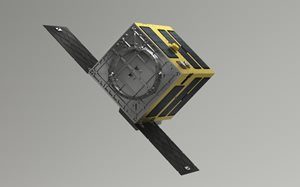
The amount of debris that’s already up there is a constant hazard to active satellites. Whether we’re checking our weather or Google Maps, traffic or day to day things activities like checking bank accounts, everything is reliant on satellite data. The more reliant we are on satellite data, the more valuable those satellites are becoming to humanity and that’s only going to increase with the Internet of Things and self-driving cars and the proliferation of video on demand. If those satellites are being threatened by pieces of uncontrolled debris in orbit, that’s a risk to all of us. We need to bring those pieces of debris down and we need to limit the risk that this potentially could have on assets providing us with this data.
The advent of cheaper launch vehicles and less expensive satellite development leads to more benefits from satellites but also to more possible risks. Large constellations have already started launching and it’s only going to get more crowded and more dangerous. The need for some form of debris remediation and mitigation is clear.
We like to look at the orbital environment as just another natural resource. The same way we look at rivers or lakes or oceans or mountains. We need to protect it.
To answer the first part of your question, yes, we’re working on the technology but we’re also working on the policy and we’re also working on the business case. All three of those things are connected. We have teams that are primarily working on building the technology for our technology demonstration mission but we’re also out there talking to governments and to businesses to show that we have a solution and it will be in the best interest of the satellite operator, the government and humanity to come up with solutions. We think that Astroscale plays a pretty unique role in this because we’re one of the few companies that is talking about this on an end-to-end basis.
We are building a big team where we have experts, not just on the technology side, but with people who have direct connections to government officials. We have people who were business majors and public affairs experts who can articulate the business case necessary to create a long-lasting sustainable business and solution.
I’ve been following the space debris debate and how different space agencies are tackling the issues. And it’s a lot of talk. I always think it’s interesting to see how debate differs based on who you talk to. Do you bring it back? Do you reuse it or you just ship it further down so we don’t see it anymore?
People in our community generally get it. But the general public doesn’t always see it as the highest priority. You can’t see space like you can see a river or an ocean. So even if space is polluted, it doesn’t resonate with the majority of the population. I think there is a change in perception though, similar to the shift we experienced in terrestrial environmental protection. Up until just about 50 years ago, a company could dump waste into a river and have the mentality that the ocean is huge and these actions would not impact anybody. It’s that same kind of mentality that people had with space debris until recently. The perception on global environmental pollution has changed and I see this happening with the perspective on orbital pollution as well. People are starting to become aware of the fact that it’s not okay to just leave trash up there. Commercial companies are very cognizant of this and they’re being proactive and making changes. There are a lot of questions about how to take those next steps, technically and that’s going to continue to be discussed. But there are people talking about real solutions now, real actionable solutions. So, in that sense, it’s really heartening to see how that change has happened.
Can you tell me more about the concrete steps that the Japanese government is taking to tackle this issue? I read that Astroscale is a part of the Space Policy Committee.
There are a few different committees and groups in Japan that are addressing various issues related to space. Space security in Japan has actually become a pretty important topic over the last five to seven years and one of the main focus areas has been SSA or space situational awareness. That includes monitoring debris and other potential threats in orbit to assure there are no collisions and assets operate safely.
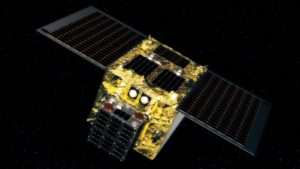
In addition to SSA, more focus is now being placed on space traffic management and active debris removal. At the G20 summit in Osaka, Japan in June this year, Prime Minister Shinzo Abe announced that Japan will conduct a trial to remove a piece of debris with a goal to commercialize the technology by 2025. We are very excited about these kinds of missions. There is also a lot of discussion within the Japanese government about instituting regulations on space debris. It’s hard to do, of course, but each domestic government has their own path toward how they might implement policies that would limit the amount of debris. We are pretty well connected to the policymakers in Japan and around the world, so we’re able to talk with them often and provide them with updates about what we’re learning in our research and our plans. And we see that this could lead to potential missions.
That’s also happening in Europe. We’re hopeful that, in the future, we’re going to see countries actually put budgets towards missions to bring down pieces of dangerous debris. We are very active in Japan, the US and the UK, staying pretty closely connected to policymakers in all three countries.
This, actually leads me to my to the next question. How do you cooperate with the space agencies? I know you have some cooperation established with ESA and I’m wondering if you’re planning to expand this. What are your plans? How do you see your work with space agencies when it comes to space debris removal?
First of all, there are basically two business lines that we are thinking about – one of those is with commercial companies who would be interested in our end of life services. For a company launching multiple satellites there is an interest in making sure that any satellite that fails is brought out of commission as soon as possible. So before launch, we are proposing that a docking plate is attached to all satellite busses that will allow for easier attachment by our servicing satellite. Our first technology demonstration mission is going to prove this capability. This mission, which is scheduled to launch in 2020 is going to show how we can dock with a satellite using a magnet and a docking plate. In the future, if a satellite that has our docking plate attached fails, we can go up and attach to the plate magnetically with a robotic arm and easily bring that satellite down. So in that sense, one mission of ours is talking to some of these commercial companies to convince them to put something on their satellite that makes it easier to remove them in case of failure.
The second business line is servicing governments. And that gets to your question about working with the space agencies. What we’d like to do with the governments is talk to them about commiting budgets for missions to grab and remove a failed satellite or upper stage rocket engine that was launched by a government agency. Studies show that, if we can just remove a few of these big, large, environmentally critical pieces of debris a year, say three to five a year, we will drastically reduce the possibility that an accident will occur. So we’re working with the space agencies by talking to them about funding missions to go out there and grab a couple pieces a year to start reducing that risk of collision.
We’re doing most of the R&D of our space segment here in Tokyo. We’re close to JAXA Headquarters and to facilities where JAXA kindly cooperates with us use for testing. Both ESA and JAXA have been extremely supportive and have been great partners. We recognize the need for both commercial and institutional partners to work together to make this a success.
So basically all the stakeholders together.
Yes, everyone has to be included. Government and industry must work together on this. Frankly no space company is really going to survive if they just focus on one of these two. Both have to work together.
Can you tell me more about the missions of Astroscale. And are you planning any new ones or these are going to be the main focus?
One mission we have that is a bit separate from our primary goal of debris removal is the Lunar Dream Capsule Project. Ths initiative was one of the first pursued by the company. We’re planning to launch a time capsule to the moon that will contain messages from people throughout Asia. We hope to launch in 2021 with Astrobotic on a ULA Centaur rocket.
Our first mission actually launched in November of 2017. Called IDEA-OSG1, this mission was meant to monitor sub-millimeter debris in low-Earth orbit. There were about 3000 conductive electrical lines on the satellite and when one of those lines was pierced by a piece of micro debris, we would be able to tell the size, the shape, the speed, the altitude of that piece of debris, which would give us a more comprehensive understanding of the debris environment. Most of our measurements of the debris environment are from ground-based sensors, so a mission in orbit would have given us a bit more of a holistic understanding. Unfortunately, that mission was on a Soyuz rocket that launched in November of 2017 and failed to make it to orbit.
Our main focus right now is on ELSA-d, which is our first technology demonstration mission for capturing debris and is scheduled to launch in 2020 .
The mission consists of two spacecraft, a Servicer (~184 kg) and a Client (~16 kg), launched stacked together. The Servicer is equipped with proximity rendezvous technologies and a magnetic docking mechanism, while the Client has a ferromagnetic plate which enables it to be docked with. The Servicer will repeatedly release and dock the Client in a series of technical demonstrations proving the capability to find and dock with debris. It’s ambitious.
In all of these cases, we are aiming to prove a capability that would be attractive to a private company or a commercial provider or to a government. If your piece of debris is tumbling, we’re developing the capability to find it. While we’re preparing for this mission from a technical perspective, we are also pursuing other mission opportunities. We are discussing potential missions with space agencies and talking to some of the large constellations, such as the ESA/OneWeb Sunrise Project, and working with them on the potential for future missions down the line.
Finally, could you tell me more about the award you received in the end of 2018 from Forbes Japan?
 We’re honoured to have received the Start-up of the Year award from Forbes in 2018. Our CEO was on the cover of the magazine here in Japan and this means that what we are doing has an impact on people and we are bringing social benefit. It shows that the business case we are bringing exists, and there’s a path towards success that people didn’t think existed when this company first started.
We’re honoured to have received the Start-up of the Year award from Forbes in 2018. Our CEO was on the cover of the magazine here in Japan and this means that what we are doing has an impact on people and we are bringing social benefit. It shows that the business case we are bringing exists, and there’s a path towards success that people didn’t think existed when this company first started.
We’ve grown our company from around 20 people to over 90 over the last 2 years. We’ve opened up an office in the UK and most recently in the US. We recognize how important it is to be connected to the US market and will continue to hire a lot of smart, talented engineers and policy and business experts to help grow the office. So the award from Forbes gives us great motivation to keep pushing forward.
Bio: Chris served as the NASA Attaché for Asia, the senior space policy official in the US.Embassy Tokyo, from 2012-2017. In that capacity he identified multiple opportunities for cooperation in the region; served as strategic space advisor to the US Ambassador to Japan and senior US Government officials; acted as an official intermediary between NASA and its partners in Asia in negotiating agreements and resolving disputes; and participated in numerous outreach events highlighting NASA activities.
Chris began working for NASA as a Presidential Management Fellow in 2003. While at NASA he was a leader in forging international cooperative partnerships around the world in the fields of Earth science, space science and human space exploration. From 2005- 2007 Chris was the Executive Director of the NASA Advisory Council, which provided advice to senior NASA officials on future policies and plans. Chris received a BA in History and Education from the University of Richmond (Va.) in 1995 and an MA in International Relations from the University of Rhode Island in 2002. In 2009 Chris earned an MBA from the McDonough School of Business at Georgetown University.
SpaceWatch.Global thanks Chris Blackerby of Astroscale for the interview.



